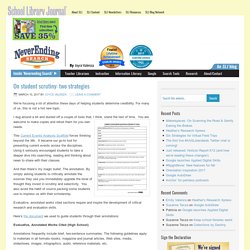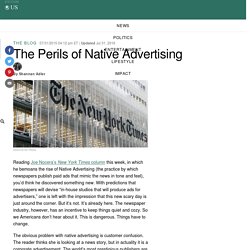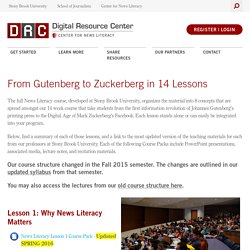

Teaching Your Students About Fake News - Listenwise Teacher Support Center. Journalism, Backwards Design, and the ACRL Framework for Information Literacy. I am fortunate to teach a journalism program in my library.

Libraries are the perfect place to host programs that nurture media creation, information literacy, and civic participation. I wrote this summer about my enthusiasm for the ACRL Framework for Information Literacy. The following are a couple of assignments I designed using the framework to craft rubrics for assessment. My advanced students (seniors) are completing an annotated bibliography and literature review, while my up-and-coming journalists (sophomores and juniors) are preparing a portfolio.
Essentially, to develop these assignments I did the work of backwards design. Annotated Bibliography and Lit Review Overview: This assignment challenges journalists to deepen their expertise and understanding of a topic they are interested in by developing an annotated bibliography and performing a literature review. Information is the lifeblood of a healthy democracy. Patterson proposes “knowledge-based journalism” as a corrective.
On student scrutiny: two strategies. We’re focusing a lot of attention these days of helping students determine credibility.

For many of us, this is not a hot new topic. I dug around a bit and dusted off a couple of tools that, I think, stand the test of time. You are welcome to make copies and retool them for you own needs. This Current Events Analysis Scaffold forces thinking beyond the Ws. And then there’s my magic bullet. Evaluative, annotated works cited sections require and inspire the development of critical research and evaluation skills. Here’s the document we used to guide students through their annotations: Evaluative, Annotated Works Cited (High School) Annotations frequently include brief, two-sentence summaries.
Check with your teacher to see which of the following elements you should include in your annotations: Author’s credentials (these may be contextual–relative to the format, situation or information need)Intended audience (For whom was this work produced and why?) Fake News Resources Update - Google ドキュメント.
Identifying Fake News: An Infographic and Educator Resources - EasyBib Blog. Lesson Plan: How to Spot Fake News. The problem of fake news came to a dizzying head in 2016 when a man fired a shot in a family pizzeria as he “self-investigated” a false report of a child abuse ring led by top democrats.

A BuzzFeed report confirmed that fake news stories, such as the one that claimed Hillary Clinton sold arms to ISIS, were actually viewed more times than articles from established and legitimate news sources. Did fake news have an impact on the election? How do we address the problem from here? This lesson plan features a Channel One News report on the problem. Then, students analyze the problem and consider steps media outlets and individuals need to take to prevent the viral spread of propaganda. Opening Activity Warm up: Ask students: How do you get your news?
The Perils of Native Advertising. Reading Joe Nocera’s New York Times column this week, in which he bemoans the rise of Native Advertising (the practice by which newspapers publish paid ads that mimic the news in tone and feel), you’d think he discovered something new.

With predictions that newspapers will devise “in-house studios that will produce ads for advertisers,” one is left with the impression that this new scary day is just around the corner. But it’s not. It’s already here. The newspaper industry, however, has an incentive to keep things quiet and cozy. So we Americans don’t hear about it. The obvious problem with native advertising is customer confusion.
Native advertising is not new. Consider what the Times has been up to. Now, it’s not surprising that Nocera appears unaware of what’s going on at his own paper. The Times and most other major publishers take care to label these ads as “paid posts,” so as to try to preserve the editorial credibility of the paper and to honor its responsibility to readers. 15 Lesson Plans For Making Students Better Online Researchers.
Fake images/videos. 5w example. Evaluating sources (the 5Ws) From Gutenberg to Zuckerberg in 14 Lessons. The full News Literacy course, developed at Stony Brook University, organizes the material into 8 concepts that are spread amongst our 14 week course that take students from the first information revolution of Johannes Gutenberg's printing press to the Digital Age of Mark Zuckerberg's Facebook.

Each lesson stands alone or can easily be integrated into your program. Below, find a summary of each of those lessons, and a link to the most updated version of the teaching materials for each from our professors at Stony Brook University. Each of the following Course Packs include PowerPoint presentations, associated media, lecture notes, and recitation materials. Our course structure changed in the Fall 2015 semester. The changes are outlined in our updated syllabus from that semester. You may also access the lectures from our old course structure here. Lesson 1: Why News Literacy Matters News Literacy Lesson 1 Course Pack - Updated SPRING 2016 Lesson 2: The Power of Information Lesson 11: Says Who?